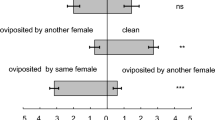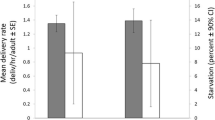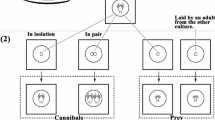Summary
The research addressed two questions: (1) doIguana iguana hatchlings recognize their kin, and (2) what are the recognition mechanisms? Eggs were collected from wild and captive-raised females and hatched in semi-natural incubators. In the first experiment we used eggs from two females. One of the clutches was subdivided to be placed in different incubators. Immediately after emergence one of these hatchling groups was introduced into a 10 m x 10 m enclosure. At the same time we introduced hatchlings from another female. The remaining hatchling group was kept separate for 3 weeks and was then introduced into the same cage. Unrelated hatchlings separated from each other. Related but separated hatchlings grouped according to introduction date. In the second experiment we maintained eight kin groups in individual cages and two hatchlings per kin group in an additonal cage. Hatchlings from the mixed group showed no preference for their kin before physical contact with pure kin groups had occurred. After physical contact hatchling recognized their kin by feces smell. Body odor is likely to be also involved.
Similar content being viewed by others
References
Alexander RD (1979) Darwinism and human affairs. Univ Washington Press, Washington
Bateson PPG (1982) Preferences for cousins in Japanese quail. Nature 295:236–37
Beecher IM, Beecher MD (1983) Sibling recognition in bank swallows (Riparia riparia). Z Tierpsychol 62:145–50
Beecher MD (1982) Signature systems and kin recognition. Am Zool 22:477–90
Bellairs A (1970) The life of reptiles, vol 2. Universe Books, New York
Bissinger BE, Simon CA (1981) The chemical detection of conspecifics by juvenile Yarrow's spiny lizard,Sceloporus jarovi. J Herpetol 15:77–81
Blaustein AR (1983) Kin recognition mechanisms: Phenotypic matching or recognition alleles? Am Nat 121:749–54
Blaustein AR, O'Hara RK (1981) Genetic control for sibling recognition? Nature 290:246–48
Blaustein AR, O'Hara RK (1982) Kin recognition inRana cascadae tadpoles: maternal and paternal effects. Anim Behav 30:1151–57
Bock BC (1984) Movement patterns relative to nest site locations in a population of green iguanas (Iguana iguana). Unpublished Ph.D. Dissertation. University of Tennessee, Knoxville, Tenn
Burghardt GM (1977) Of iguanas and dinosaurs: social behavior and communication in neonate reptiles. Am Zool 17:177–90
Burghardt GM, Greene HW, Rand AS (1977) Social behavior in hatchling green iguanas: Life at a reptile rookery. Science 195:689–91
Burghardt GM, Rand AS (1985) Group size and growth rate in hatchling green iguanas (Iguana iguana). Behav Ecol Sociobiol 18:101–104
Davis LS (1982) Sibling recognition in Richardson's gound squirrel (Spermophilus richardsonii). Behav Ecol Sociobiol 11:65–70
DeFazio A, Simons CA, Middendorf GA, Romano D (1977) Iguanid substrate licking: a response to novel situations inSceloporus jarrovi. Copeia 1977:706–709
Dugan BA (1982) The mating behavior of the green iguana,Iguana iguana. In: Burghardt GM, Rand AS (eds) Iguanas of the World: Their behavior, ecology and conservation. Noyes, Park Ridge, NJ
Duvall D (1979) Western fence lizard (Sceloporus occidentalis) chemical signals. I. Conspecific discriminations and release of a species-typical visual display. J Exp Zool 210:321–326
Getz WM (1981) Genetically based kin recognition systems. J Theor Biol 92:209–26
Getz WM, Brueckner D, Parisian TR (1982) Kin structure and swarming behavior of the honey beeApis mellifera. Behav Ecol Sociobiol 10:265–70
Gravelle K (1981) Chemical communication in the iguanid lizardSceloporus jarrovi PhD dissertation, Hunter College of the City University of New York
Harris DM (1982) The phenology, growth, and survival of the green iguana,Iguana iguana, in northern Columbia. In: Burghardt GM, Rand AS (eds) Iguanas of the world: Their behavior, ecology, and conservation. Noyes, Park Ridge, NJ
Holmes WG (1984) Sibling recognition in thirteen-lined ground squirrels: effects of genetic relatedness, rearing association, and olfaction. Behav Ecol Sociobiol 14:225–33
Holmes WG, Sherman PW (1983) Kin recognition in animals. Am Sci 71:46–55
Lacy RC, Sherman PW (1983) Kin recognition by phenotype matching. Am Nat 121(4):489–512
Marler P (1976) Sensory templates in species-specific behavior. In: Fentress JC (ed) Simpler networks and behavior. Sinauer, Sunderland, Mass
Pfennig DW, Gamboa GJ, Reeve HK, Reeve JS, Ferguson ID (1983) The mechanism of nestmate discrimination in social wasps (Polystes, Hymenoptera: Vespidae). Behav Ecol Sociobiol 13:299–305
Rand AS (1968) A nesting aggregation of iguanas. Copeia: 552–61
Rand AS, Dugan BA (1980) Iguana egg mortality within the nest. Copeia: 531–34
Rand AS, Greene HW (1982) Latitude and climate in the phenology of reproduction in the green iguana,Iguana iguana. In: Burghardt GM, Rand AS (eds) Iguanas of the world: Their behavior, ecology, and conservation. Noyes, Park Ridge, NJ
Siegel S (1956) Nonparametric Statistics for the behavioral sciences. McGraw-Hill, Kiogakusha
Simon CA (1983) A review of lizard chemoreception. In: Huey RB, Pianka ER, Schoener TW (eds) Lizard ecology: Studies of a model organism. Harvard University Press, Cambridge Massachusetts London
Simon CA, Gravelle K, Bissinger BE, Eiss I, Ruibal R (1981) The role of chemoreception in the iguanid lizardSceloporus jarrovi. Anim Behav 29:46–54
Troyer K (1984) Behavioral acquisition of the hindgut fermentation system by hatchlingIguana iguana. Behav Ecol Sociobiol 14:189–193
Underwood G (1951) Reptilian retinas. Nature (Lond) 167:183–185
Van Devender RW (1982) Growth and ecology of spiny tailed and green iguanas in Costa Rica, with comments on the evolution of herbivory and large body size. In: Rand AS, Burghardt GM (ed) Iguanas of the world: Their behavior, ecology and conservation, Noyes, Park Ridge, NJ
Vidal JM (1982) Auto-imprinting: Effects of prolonged isolation on domestic cocks. J Comp Physiol Psychol 96:256–67
Waldman B (1981) Sibling recognition in toad tadpoles: the role of experience. Z Tierpsychol 56:341–58
Waldman B (1982) Sibling association among schooling tadpoles: Field evidence and implications. Anim Behav 30:700–13
Waldman B (1984) Kin recognition and sibling association among wood frog (Rana sylvatica) tadpoles. Behav Ecol Sociobiol 15:171–80
Waldman B (1986) Preference for unfamiliar siblings over familiar non-siblings in American toad (Bufo americanus) tadpoles. Anim Behav 34:48–53
Weldon PJ, Bagnall D (1987) A survey of polar and nonpolar skin lipids from lizards by thin layer chromatography. comp Biochem Physiol (in press)
Werner DI, Miller TJ (1984) Artifical nests for female green iguanas. Herp Review 15(2):57–58
Author information
Authors and Affiliations
Rights and permissions
About this article
Cite this article
Werner, D.I., Baker, E.M., Gonzalez, E.d.C. et al. Kinship recognition and grouping in hatchling green iguanas. Behav Ecol Sociobiol 21, 83–89 (1987). https://doi.org/10.1007/BF02395435
Received:
Accepted:
Issue Date:
DOI: https://doi.org/10.1007/BF02395435




